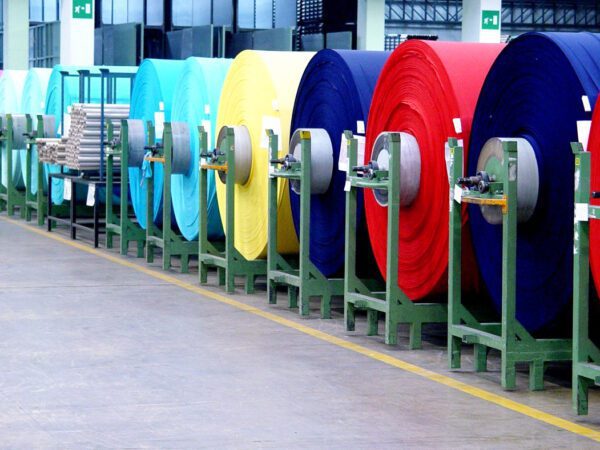
13 Sewing Hacks and Tips You Should Know for Stretch Fabric
This ultimate guide to sewing with wholesale stretch fabrics covers all the hacks that you need. Find out how to make your garments a stitch above the rest!
With autumn approaching fast, this is the best time to start thinking about the clothes you’ll make for the colder seasons. This article will give you the sewing hacks and tips for stretch fabric that you need for working with stretch fabric, from activewear to swimwear.
Sewing with stretch fabric can appear to be a daunting prospect at first, mainly if you haven’t worked with it in the past or if you’re a new needler.
The following hacks and tips will break down which stitches to use with which fabric while also looking at which settings to use on your sewing machine and if you need any extra tools to produce the best styles you can.
1. Get to know the fabric you’re working with
Before you start working with any fabric, you should get to grips with the material, as there is a wide variety of stretch fabric available.
The best way to do this is to handle the fabric carefully. Get to know where the stretches in the material are, as this differs between different types of stretch fabric.
2. Always wash the fabric beforehand
It is essential to wash the fabric before doing any work on it, which will stop it from shrinking later on.
Also, make sure that the fabric is dried before you start working with it, but you must ensure that you dry it in the best way possible. (This can vary between different fabrics.)
3. Weights or pins?
It is crucial to think about securing the patterns when you’re cutting and planning which stitch you will use. Using pattern weights as opposed to pins will ensure that there are no holes in your fabric.
You can use specially designed knit fabric pins to achieve this as well, as these can be placed within the seam allowance of a pattern and won’t leave noticeable holes in the fabric.
4. Keep Your Fabric Flat When Cutting
With that in mind, it is crucial that you keep your fabric flat and unstretched when cutting. Consider using a large table or the floor (if clean) for cutting your fabric.
5. Curling – how to stop it?
Some stretch fabrics do curl at the edges, which can make working with them difficult. If you don’t want the fabric to curl, you can spray some starch onto the cloth and iron it to keep it flat.
However, if you’re opting for a specific stitch, the curl of the fabric can work in your favor.
6. Which Thread?
It is crucial to think about which thread you’re going to be using, particularly if you’re looking at creating specific types of clothing besides activewear, such as making a kilt. For most clothing, a 40wt all-purpose polyester thread will be more than sufficient for the job.
This type of thread is ideal for stretch fabrics, as it contains a stretch within the thread itself. On the other hand, do not use cotton threads, as they don’t stretch enough for the fabric and are likely to break when the fabric is stretched.
7. Which Presser Foot to Use?
You have the option of choosing which presser foot to use on your sewing machine, depending on the fabric that you’re using. For the majority of the stretch fabrics, a regular presser foot will be sufficient.
However, if you’d like a smoother operation, a Teflon sewing foot is more appropriate.
8. Several Needles, But Which One?
The sewing machine comes with several different needles, but it is vital to pick the right one for your fabric.
The ballpoint needle is ideal for stretch fabrics, as it allows the machine to glide over the fabric without putting big holes in it. You can also use the stretch needle or the twin needle, depending on the pattern that you want on your fabric.
9. Be Careful When Sewing the Fabrics Together
This information might seem like a no-brainer; the fabrics mustn’t be pushed or pulled when sewn together. Pushing or pulling them will cause visible damage to the material.
Remember to use the sewing machine slowly when doing this, as this will prevent the fabric from being damaged and deformed.
10. Which Stitch?
There are several stitch types that you could use for your fabric, giving your finished product a professional look. The recommended stitch for stretched fabric is the zig zag stitch, as this weaves in between the stretches of the fabric and allows the fabric to stretch within the thread without breaking the stitch.
You can vary the stitch lengths in small amounts as required, but remember that a longer stitch makes it easier to stretch.
11. Which Stitch For The Hem?
If you are creating a piece for professional purposes, it is essential that your finishing is of high quality.
Using the twin needle is more efficient for such quality, creating a double stitch on one side of the fabric and a zig-zag stitch at the back.
12. Sewing with Tissue Paper?
Stretch fabrics can be awkward to feed through the sewing machine if they’re exceptionally lightweight.
Be mindful to keep the fabric from distorting and getting stuck in the machine. One hack you can use is to place tissue paper beneath the fabric. This additional layer increases the tension of the fabric and is easy to remove afterward.
13. Pressing
Pressing the finished item gently after sewing can help your clothing get back into its original shape if you have found that the stitch has stretched in any way. As the fabric you’re working with is a stretch fabric, the stitch distorting after a prolonged period can occur, so you must find ways of maintaining the quality you’ve already put in.
Utilize these Sewing Hacks and Tips for Stretch Fabric (and knowledge of the right stitches, threads, and needles) to create very professional-looking garments from wholesale fabric. Although practicing is critical, you can ensure that your clothing will be a stitch above the rest!






